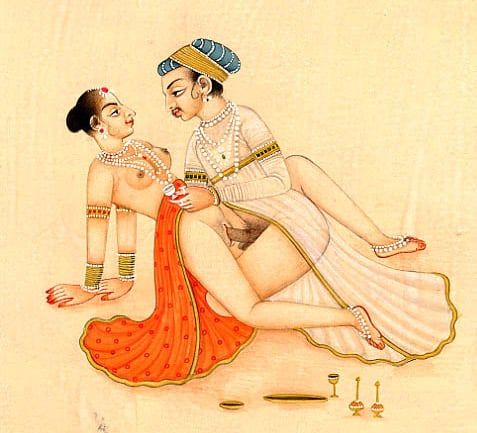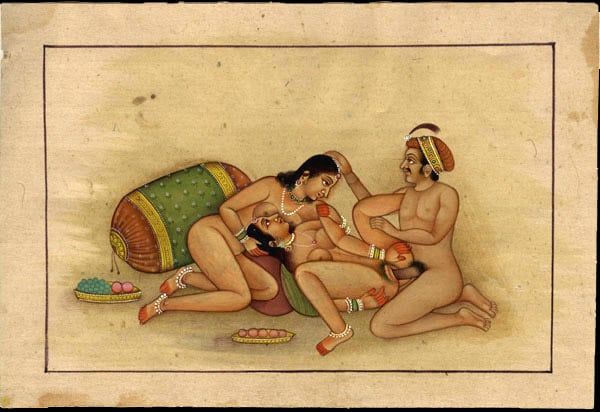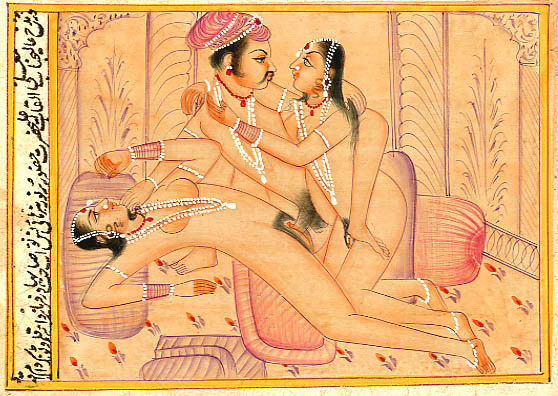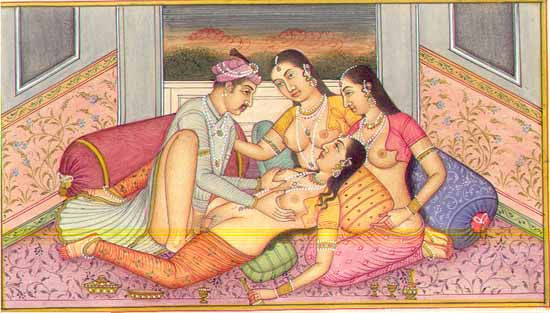First published: December 2019
Last updated: November 2024
Even today, negotiating the ups and downs of modern life, especially the transition from teen years into adulthood can be tricky for a young man. Perhaps what might be needed is some sort of guidebook to advise on subjects from managing a household to finding a wife, to pleasing a wife in bed.
At least, this is what Vatsyayana Mallanaga thought, somewhere around two thousand years ago in Ancient India, when he wrote what was essentially an instruction manual for the ‘young man about town’: the Kama Sutra.
What is the Kama Sutra?
- The Kama Sutra is best known as a manual of sex positions – and there is certainly a great deal of information about sexual acts and positions, and even how to attract the interest of a woman.
- The Kama Sutra is divided into five sections – only one or two which deal with sex and intimate matters.
- The others offer guidance on how to find and court a suitable wife, and how to socialise – what activities are recommended, and which are not, and even how to set a good work-life balance.
A Brief History of the Kama Sutra
The Kama Sutra was initially thought to have been written anything between 300 BC and 200 AD, and this understanding persisted for many years. However, a more recent translation – looking closely at tribes and events mentioned in the text – has allowed the work to be dated more precisely to having been written in the last half of the third century AD by Vatsyayana Mallanaga.
Earlier translations, were undertaken by one Richard Francis Burton in 1883. Unfortunately, he was a Victorian and saw more merit in imposing his Victorian viewpoint and thus had all mentions of female desire removed from the text, along with advice on how to ensure that the female partner enjoyed orgasm.
The Kama Sutra opposed Victorian British values and was dismissed as ‘pagan nonsense’ and something to be actively stamped out. Burton, even had he wanted to accurately translate the text as it stands, would have most likely fallen afoul of anti-obscenity laws. As it was, his wildly inaccurate text had to be printed under the imprint of a publishing house that Burton himself set up for the purpose, and was designated ‘for private distribution only’.
Fortunately later translations, in particular those by S. C. Uphadyaya, published in 1961, and Wendy Doniger and Sudhir Kakar, published in 2002, bestowed more respect onto the original teachings, and are more faithful reproductions of the author’s intentions.
The latest version, by Doniger and Kakar, is widely acclaimed as ‘the’ translation – although it, too, has some detractors. Some critics claim that Doniger inserts – as did Burton all those years ago – her own points of view and sometimes allows personal opinions to colour phrasing and interpretations instead of fiercely clinging to the essence of the text.
What Does The Kama Sutra Detail?

The benefits of the Kama Sutra are many and varied and can be divided into two parts:
- The first on acceptable social behaviour in public – dealing with work, leisure and how to meet women.
- The second on how to behave in private – dealing with sexual union and pleasing one’s lover. Let us have a look in more detail at some of the benefits of this ancient text’s wisdom:
Work and Play
The text is told from the point of view of an unnamed ‘man about town’, by which the writer is understood to mean a young man, just having come of age, who is looking to begin making his way in the world.
The text describes how he should conduct himself. Education and the accumulation of knowledge and learning are important, the text says, and a man should do all he can to better himself. This part of the text was invaluable to young men who were given no sex education as we understand it today, but would have been filled with curiosity and interest.
Finding Girls
An understanding of women and what women want is key to having fruitful and enjoyable relations, the Kama Sutra tells our young man. But before any sex can be enjoyed by either gender, one must first meet a girl.
The text details where a respectable young man might meet a girl, and even details how to talk to her. The text even advocates the use of a potential ‘go-between’, someone known to both parties who can speak freely to both about their interest (or lack thereof) in each other.
The text even says that a determined young man can use a female messenger if his chosen beloved ignores his advances and is not accessible to a male go-between. The text does caution, however, saying that whenever possible, the young man should make his own advances as his courageous display is more likely to win him favour.
Earning a Wife
Getting married in ancient Hindu society was no simple love match. Rather, the right woman had to be found, with not only her family, temperament and looks to be taken into account, but also such minutiae as her age which ‘should be three years or more younger than his own age’.
Finding the right wife, the text tells us, will bring to the young man ‘offspring, affinity, and the increase of friends’, as well as ‘untarnished love’. With so much riding on choosing the correct woman, it is almost certain that many young men must have pored over the text, offering a quick but heartfelt ‘thank you’ to the wise author!
The Importance of Sexual Pleasure

Of course, the Kama Sutra is best known as a picture book of sexual positions – some people even today have the erroneous impression that there is no text at all. But the Kama Sutra in its original form never had any pictures included at all.
Instead, the author painstakingly broke down men and women into categories – for example based on their libido, indicating which matches would be evenly balanced and which might end up in strife, such as if a woman with a high libido ended up with a man who had a lower sex drive.
Despite the lack of pictures, the text is clear in description and the instructions and informational snippets are easy to understand: for example, ‘when a man enjoys many women altogether, it is called “congress of a herd of cows”‘. While this may seem insulting to the modern Western mind, bear in mind that in Hinduism, cows are sacred creatures so the line is probably quite a beautiful one, in fact.
The text stresses the importance of sexual intercourse as a measured expression of consensual love between male and female, and prohibits ‘unrestrained’ sex with women who are not willing. Intercourse, the book counsels, should follow thought and even discussion beforehand.
In fact, the book even advises women how and when to read the text, in order that they too, might know what to expect from a respectable suitor, what touching may or may not be appropriate and in what situations, as well as learning about sexual positions and how to both please and be pleased by one’s lover.
The text places a lot of importance on the pleasures of the sex act – the various sex acts – understanding that a good and healthy sex life is a sign of a happy marriage and partnership.
Alternative Lifestyles
Same sex relationships are discussed, and not – as one might superficially assume – in a disapproving way. While some early translations have rendered the practises as being unsavoury, the original text do not condone same sex relationships.
The texts speak of some people of a ‘third nature’ (nature meaning sexuality, according to Doniger), which these days would probably translate to something like ‘non-binary’.
It refers to ‘women who act like men’ and ‘men who act like women’ and from the context it is clear that both male and female same sex relationships were known about and were generally accepted.
Mention is also made of bisexual relations, early BDSM practices, and even group sex.
What To Do When Boredom Sets In
It is a given, in the Kama Sutra, that feelings towards a partner will change over time, on either side. Women, having given birth, might not be interested in sex any more, whether short term or long term. Men, as they age, might lose their fiery libido, leaving their female partner high and dry. Therefore, the text details ways of breaking up with an unsatisfactory lover.
There is a large section on courtesans: how to find and engage them, how much and when to pay them, and what to expect for your money. Although this could be construed as a misogynistic chapter, the text recommends being polite and respectful to the courtesans for no other reason than civility and good manners. Courtesans are not at all looked down on for their career choices, instead they are mentioned as being providers of a vital service.
Sexual Union

Before going on to detail the many forms of touching and sexual congress, the text gives a list of women who should not be considered as suitable partners: these include female relatives, close female friends, lepers, women who smell bad, a mentally ill woman, women who are too fair or too dark-skinned, and the wives of kings, friends, relatives and aristocracy.
The Kama Sutra goes into great detail about ways of touching a potential lover, from a woman putting a hand on a man’s chest, all the way to full intercourse. The text says there are four types of embrace, each to be used at different points in the relationship. The four types of embrace are:
- Touching
- Piercing
- Rubbing
- Pressing
Piercing is not, as one might assume, referring to sexual penetration. Piercing, according to the work, is when a woman presents a man with a clear view of her breasts, and he takes hold of them. Piercing and touching are the only two ways in which people unknown to each other might be able to interact physically.
Rubbing is what we might call a full-body embrace, such as when lovers are kissing and press the whole length of their body against their partner.
Pressing is when the whole weight of the active partner (usually, but not always, the male) presses the other against a bed or pillar. Rubbing and pressing embraces are often combined with sexual intercourse, or precede it.
The text goes on to acknowledge that it is not the last and only word in matter of sex: ‘even those embraces that are not mentioned in the Kama Sutra should be practised at the time of sexual enjoyment, if they are in any way conducive to the increase of love or passion.’
Pleasure and Spirituality

It has long been acknowledged that there is a link between sex and spirituality, with a fulfilling sex life improving mental health and keeping one’s mood balanced and serene. Some ancient cultures believed that at the moment of orgasm, the mind emptied of all petty worries and thoughts, enabling the person to truly connect with the divine.
The Kama Sutra makes no such sweeping claims, but it certainly acknowledges the physical and mental health benefits of regular consensual and orgasmic sex. The text even argues against objections by the more prudish of the time when it was written, who claimed that sex for pleasure’s sake was surely sinful. The text responds that pleasure, especially sexual satisfaction, is as much a need as the need for air, food, and shelter.
The text goes onto claim that being sexually satisfied is vital in order for a person to live well and in honour of the gods. This is actually a belief ahead of its time as far as West beliefs go: it is only in the last century or so that sexual desire has been acknowledged as natural and positive, rather than something a bit mucky to be ignored and subsumed at every opportunity.
With that in mind, let us have a look at some of the best recommended sexual positions of the Kama Sutra!
5 Kama Sutra Positions for Better Sex
The text says that practising in water – especially the more complicated positions where one’s body weight must be held by one’s partner – is ideal, although this was frowned upon by some elements of society. Today, however, a sex swing might be the ideal answer to working your way through the joys of the Kama Sutra’s best!
Position of Indrani
With this position, the woman lies on her back, relaxed. She raises her legs as high as they will go – for very flexible women this means that her thighs will be resting on her stomach. This position, the text cautioned, is not for everyone and might need practice to get it right.
This position is a great one as it allows the man to deeply penetrate the woman, which feels great for him, and – unlike many other missionary-based positions – will give her a good chance of enjoying a blended orgasm.
The Tigress
This is a gorgeous and playful female on-top position, and it is an easy and straightforward position. The man lies on his back with his legs together. His lover straddles him (not facing him) whilst supporting her weight with her hands, which should rest near the knees (or shins) of her lover. This position is commonly known today as ‘reverse cowgirl’ and this is a firm favourite that has stood the test of time!
Pressed Position
With the pressed position, the woman again lies on her back. The man lifts and holds her feet and legs up by his chest, using her body to leverage his own movements.
This position is fantastic for both men and women. The angle of the woman’s hips in the pressed position means that he will be rubbing against the frontal vaginal wall, stroking the G spot with each thrust. This is a classic move that offers deep penetration.
Congress of a Cow
This position, once described, will be easily recognised. The woman goes on hands and feet, or hands and knees in front of the man, while he enters her from behind. It is simply what is known now as doggy style! Again, as mentioned above, references to ‘cows’ are not as demeaning as they might have taken to be by Western minds, given the religious importance of cows to Hinduism.
Yawning position
This position, despite its name does not refer to being bored in any way, shape or form! With this position, the woman once again lies on her back, and spreads her legs as wide apart as possible, with the man holding her legs wide.
This position is probably so named because the act of lifting and spreading her legs causes everything to open up for him, allowing deep penetration. This is one of the most recommended sexual positions as it gives great pleasure to both partners. It is also very arousing because the woman surrenders herself completely and offers her sexual soul to her lover.
More than Just Sex
It must be stressed that the Kama Sutra is far more than a sex-guide. While it certainly does give a great deal of information and detail about sexual practises, it also recommends much else to do with living well and being a good member of society.
Women are treated as equals and as deserving of sexual satisfaction as men are, and there are many lists within the work detailing other subjects that each person, be it a woman (married or virginal maid) or a young man-about-town, should study in order to be a well-rounded and healthy person: these include singing, painting, tattooing, cooking, interior design and so much else.
While many of the activities and suggestions are specific to ancient India, there is still much in the Kama Sutra that can be applied to modern life. Including, of course, the advice on giving and taking pleasure in bed!
To conclude: the Kama Sutra is not and never has been a general guide book for life. It was aimed at a certain subsection of Indian life: the wealthy middle-class and above, specifically for younger people (although there is the odd piece of advice that might be relevant to an older person). This can be seen with the advice on how to speak politely to various members of society, the near obsession with sexual satisfaction and the minutely detailed descriptions on how to introduce oneself and begin a liaison.
The many mentions of servants and large houses, the expectation that certain luxuries will be readily to hand and the leisure to attend gatherings and parties, all speak to the expected lifestyle of the reader.
And in fact, this was probably reasonable: it is unlikely that poor classes would be able to read, and certainly not for pleasure.
But the Kama Sutra still has much to offer the modern world: it seems that human desires and pleasures have changed very little over the millennia – despite the frequent swings from conservative to liberal and back again that occur, with one generation’s prudery becoming the next’s hedonistic enjoyment!
